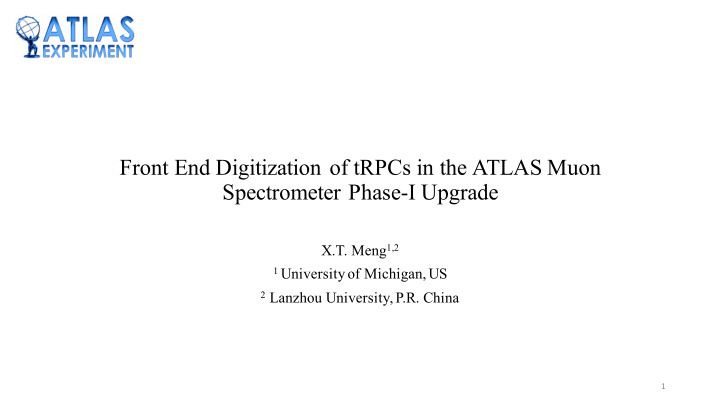



Front End Digitization of tRPCs in the ATLAS Muon Spectrometer Phase-I Upgrade X.T. Meng 1,2 1 University of Michigan, US 2 Lanzhou University, P.R. China 1
Outlines • Introduction of the Front End Signal Digitization- High Performance Time to Digital Converter (HPTDC) chip • Latency simulation and hardware test • Prototype design and test • Front End digitization card design • Conclusion 2
ATLAS thin RPC trigger upgrade project L1_MU20 Rol(25ns) tRPC+sMDT NSW q Current ATLAS muon trigger has a problem of large fake LVL1 trigger rate. v 70% of the rate from | η | >1.3. v 22% of the rate from 1.0< | η | < 1.3 q To reduce fake rate: v The New Small Wheels(NSW) in ATLAS muon Phase-I upgrade cover transition region 1.3< | η | < 2.5. v thin Resistive Plate Chambers( tRPC ) and small_tube Monitored Drift Tube(sMDT) chambers cover 3 1.0< | η | < 1.3.
thin RPC readout tRPC readout electronic total latency requirement: 43* BC=1075ns time(ns) components 4 m cable TOF 27 ± 1 10 Strip propagation ASD+TOT 10 Digitization <350 GOL(Gigabit Optical Link) 50 Pad board <160 black diagram of readout of tRPC Fiber to USA15 416 ± 24 High Performance Time to Digital Converter (HPTDC) is a multi-channel Time-to-Digital (TDC) ASIC. Option considered to digitize the detector signal from tRPC detector. 4
thin RPC front end board from Giulio Aielli’s talk Each front end board will handle 8 strips signals, and send 8 Low-voltage differential signaling(LVDS) signal to digitization card. 5
HPTDC key features § 32 TDC channels § Trigger mode / triggerless mode 32 channels § Three types of readout: parallel, serial and hits byte-wise readout § Programmable time resolution § Internal logic core speed: 40 MHz, 80 MHz, 160 MHz § Four types of measurement modes: Readout FIFO shared by 4 groups Parallel/serial/ byte-wise readout 6
Latency definition in the HPTDC Data_ready is a flag to show 32 bit parallel data of hit is sent out from HPTDC, so latency is time difference between the leading edge of hit and the leading edge of its correspond data_ready flag 7
Latency simulation summary To study the latency of HPTDC in the triggerless mode for the ATLAS tRPC upgrade: 1. Core clock speed should be set at 40, 80, 160 MHz (80 MHz was selected) 2. The number of correlated hits in one RPC layer from a single track ( 1-3 ) 3. Correlated hits should be distributed either to a. sequential channels in the same memory buffer b. alternating channels in each of four memory buffers 4. Measurement mode can be set to either leading edge mode or pair mode. Based on the simulation results, we design a prototype of digitization card to measure latency and evaluate the combined function of HPTDC and GOL. Results are shown in the following slides 8
Prototype of digitization card Schematic of prototype prototype 9
Setup of latency test Real setup Schematic of setup 10
alternating mapping vs Sequential mapping There are two mapping for the connection between strips of tRPCs and input of HPTDC: alternating mapping and sequential mapping. Sequential mapping alternating mapping 11
alternating mapping vs Sequential mapping 300 kHz random hit @ 24 channel as background For sequential mapping 3 kHz simultaneous hit @ channel 0,1,2. For alternating mapping: 3 kHz simultaneous hit @ channel 0,8,16. 12
Number of simultaneous hits Using alternating mapping; 300 kHz random hit @ 24 channel as background For 2 simultaneous hit 3 kHz simultaneous hit @ channel 0,8. For 3 simultaneous hit 3 kHz simultaneous hit @ channel 0,8,16. For 6 simultaneous hit 3 kHz simultaneous hit @ channel 0,8,16,24,1,9. 13
Measurement mode Using alternating mapping; 300 kHz random hit @ 24 channel as background For leading edge: 3 kHz simultaneous hit @ channel 0,8. For pair mode: 3 kHz simultaneous hit @ channel 0,8. 14
Final Prototype Test of HPTDC+GOL Two KC705 FPGA evaluation board were used. One is used prototype to do configuration for HPTDC and send hit, the another one is used to receive output of GOL and send data to PC. 15
Measurement of prototype DNL for HPTDC in medium resolution mode, 1LSB=195 ps Time jitter result using 100 ns between rising edge of successive pulses 16
Front end digitization card design The total size of digitization card will be 35 cm(length)*25cm(width)*12cm(height) The design of digitization will be submit soon. 17
Conclusions A prototype was design to do the test of latency of HPTDC and the basic function of HPTDC plus GOL. Ø The latency test and simulation results show that the HPTDC can get the required latency by choosing the appropriate parameter. Ø The basic function of HPTDC and GOL have been verified on the prototype, and they can work well. Ø The front end digitization card was designed based on the prototype and will be submit soon. 18
Recommend
More recommend